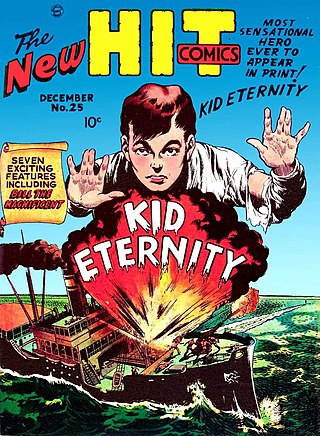
Action Comics is an American comic book/magazine series that introduced Superman, one of the first major superhero characters. The publisher was originally known as National Allied Publications, and later as National Comics Publications and as National Periodical Publications, before taking on its current name of DC Comics. Its original incarnation ran from 1938 to 2011 and stands as one of the longest-running comic books with consecutively numbered issues. The second volume of Action Comics beginning with issue #1 ran from 2011 to 2016. Action Comics returned to its original numbering beginning with issue #957.

The Silver Age of Comic Books was a period of artistic advancement and widespread commercial success in mainstream American comic books, predominantly those featuring the superhero archetype. Following the Golden Age of Comic Books, the Silver Age is considered to cover the period from 1956 to 1970, and was succeeded by the Bronze Age.

Quality Comics was an American comic book publishing company which operated from 1937 to 1956 and was a creative, influential force in what historians and fans call the Golden Age of Comic Books.

Timely Comics is the common name for the group of corporations that was the earliest comic book arm of American publisher Martin Goodman, and the entity that would evolve by the 1960s to become Marvel Comics.

Blackhawk is the eponymous fictional character of the long-running comic book series Blackhawk first published by Quality Comics and later by DC Comics. Primarily created by Chuck Cuidera with input from both Bob Powell and Will Eisner, the Blackhawk characters first appeared in Military Comics #1.

James F. Steranko is an American graphic artist, comic book writer/artist, comics historian, magician, publisher and film production illustrator.
Amazing Adventures is the name of several anthology comic book series, all but one published by Marvel Comics.

Fawcett Comics, a division of Fawcett Publications, was one of several successful comic book publishers during the Golden Age of Comic Books in the 1940s. Its most popular character was Captain Marvel, the alter ego of radio reporter Billy Batson, who transformed into the hero whenever he said the magic word "Shazam!".

Jane Arden was an internationally syndicated daily newspaper comic strip which ran from November 26, 1928 to January 20, 1968. The title character was the original "spunky girl reporter", actively seeking to infiltrate and expose criminal activity rather than just report on its consequences and served as a prototype for later characters such as Superman supporting character Lois Lane and fellow comic strip heroine Brenda Starr, Reporter. Pulitzer Prize-winning columnist Mary McGrory credited Jane Arden with instilling her interest in journalism.
Paul Gustavson was a Finnish-American comic-book writer and artist. His most notable creations during the Golden Age of Comic Books were The Human Bomb for Quality Comics, and the Angel, who debuted in Marvel Comics #1, the first publication of Marvel Comics forerunner Timely Comics. The Angel would star in more than 100 stories in the 1940s. The Human Bomb would later be acquired by DC Comics and make sporadic appearances as late as 2005.
Centaur Publications was one of the earliest American comic book publishers. During their short existence, they created several colorful characters, including Bill Everett's Amazing-Man.

Everett M. Arnold, also known as Busy Arnold, was an American publisher and an early comic-book entrepreneur whose company Quality Comics published during the 1930s and 1940s period fans and historians call the Golden Age of Comic Books. He was also instrumental in the publishing arrangement that led to Will Eisner's newspaper Sunday-supplement comics series The Spirit.

Feature Comics, originally Feature Funnies, was an American comic book anthology series published by Quality Comics from 1939 until 1950, that featured short stories in the humor genre and later the superhero genre.

G.I. Combat is an American comics anthology featuring war stories. It was published from 1952 until 1956 by Quality Comics, followed by DC Comics until its final issue in 1987. In 2012 it was briefly revived.

Neon the Unknown is a fictional superhero from the Golden Age of Comic Books created by Jerry Iger for Quality Comics. Neon first appeared in a story penciled and inked by Alex Blum in Hit Comics #1 and was featured on the cover of issue two drawn by Lou Fine. His stories ran in issues 1–17.

War comics is a genre of comic books that gained popularity in English-speaking countries following World War II.
Ken Bruzenak is an American comic book letterer, primarily known for his work on Howard Chaykin’s American Flagg! Bruzenak's lettering and logowork was integral to the comic's futuristic, trademark-littered ambience. During the course of his career, Bruzenak has been closely associated with both Chaykin and Jim Steranko.

Hit Comics is a comic book anthology title published by Quality Comics during the Golden Age of Comic Books from 1940 until 1950.












